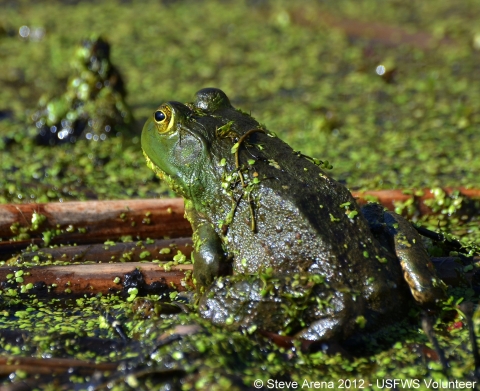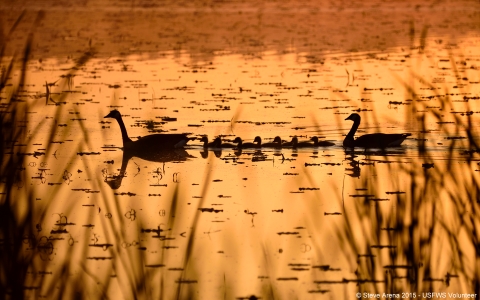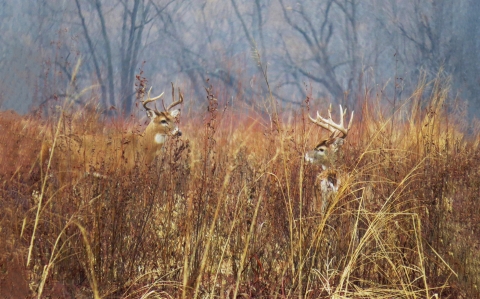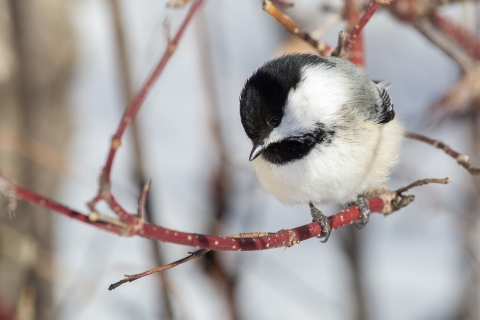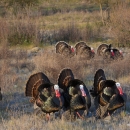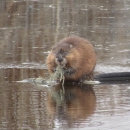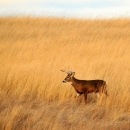Seasons of Wildlife
Spring
Spring is time for new growth and new beginnings. Amphibian species emerge from their winter retreats and move to their breeding sites, where loud breeding calls from pickerel frogs, spring peppers, gray tree frogs, bull frogs, and northern leopard frogs can be heard. Early pops of color are displayed by spring ephemerals like starflower or red trillium scattered around. Fields and woodlands start to look green again, seedlings break through the soil and trees’ buds start to grow out into leaves. Flocks of the migrant bird species make their arrival such as tree swallows, black and white warblers, turkey vultures, and ring-necked ducks. Many newborns start to venture out into their new world during spring, like feisty fox kits or prickly porcupettes.
Summer
Summer is a bustling time for all species. Wetlands are lively and noisy with birds like mallard ducks, Canada geese, and red-winged blackbirds. Reptiles, including the threatened Blanding’s turtle or northern water snake are taking advantages of the warm temperatures and are basking in the sun. Beavers are very active forging, cutting down trees, caring for young and repairing lodges. Out of the water, the eastern newt, in it's terrestrial poisonous "red-eft" life stage can be been travelling through the forest. The meadows and water's edge become an assortment of lush grasses and bright wildflowers, creating prefect habitat fr many species, including pollinators like honeybees and ruby-throated hummingbirds buzzing all around. Bats such as the Massachusetts endangered, little brown bat fill the night sky feeding on mosquitoes and beetles.
Autumn
Autumn is the calm after the hectic humid summer season. Migratory birds like yellow warblers, rose-breasted grosbeaks, waterfowl, and raptors leave for warmer wintering grounds. Some hawk species will stay year-round or pass-through Massachusetts, but broad-winged hawks are known to form large “kettles” with hundreds of individuals to travel south. Animals of all sizes from muskrats to black bears are starting to stock up caches and their stomachs with seasonal food sources like beech nuts, acorns, and berries. White-tailed deer activity is high right now because the breeding season, “the rut” is in November.
Winter
Winter is the quietest time of the year, yet wildlife is still all around us. Many songbirds stick around in colder elements including our state bird, the black-capped chickadee, and dark-eyed juncos. Small mammals like mice and voles create tunnels under the snowpack, trying to outsmart the clever coyotes and foxes hunting for them. Some species even change their fur color to help camouflage in snow like weasels and snow-shoe hares! We have many hibernators here too, such as groundhogs, insects, snakes, turtles, amphibians, and bats. One of our most impressive hibernators is the wood frog, who has special proteins in their blood which allows them to almost freeze entirely and then “defrost in the spring”.
Featured Species
The refuge provides important habitat for all species, however, specializes in migratory birds. Great Meadows has a large recorded bird list with over 220 species. Since the refuge is majority freshwater wetlands, there are many water dependent species. Several species of waterfowl including mallards, black ducks, wood ducks and blue-winged teal frequent here. Great Meadows has the largest genetically distinct population in the northeast of Massachusetts' threatened Blanding’s turtle. Biologists are trapping turtles to assess their population, do nest surveys to monitor productivity and some turtles are “head-started” with the help of local organizations and then release. Other reptiles that are common sites is the Northern water snake and snapping turtle. Signs of mammals like muskrats, otters and minks can be seen alongside the banks, some individuals are even spotted swimming. Wetlands conservation not only benefits the semi-aquatic species, but all other species that use the wetland such as pollinating insects, raptors, songbirds and mammals like raccoons, rabbits, and mice.

